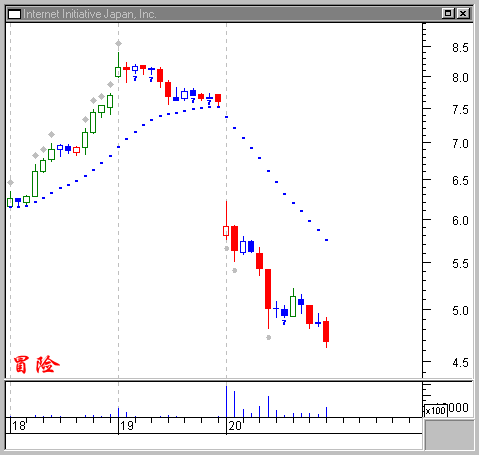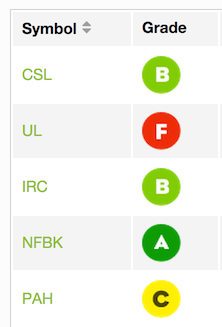Thoughts on NPR Planet Money's Short Selling Episode
Those who used to read my old blog know that I have no problem at all with short selling. See some of my old posts like 'The (Very) Basics of Short Selling', 'Short Selling *is* American' and 'Pick Your Spots When Selling Short'. So in that light,when I saw that NPR's Planet Money podcast did two episodes about short selling I was very interested in seeing how they'd handle the subject. The second of those episodes was the story of the first short sale ever, which was back in the days of The Dutch East India Company:
There have been short sellers throughout history. Today, the story of a man who was the very first short seller. The first person to bet that a stock will go down. It doesn't go well for him.
That was a very interesting story but I want to focus on the first of the recent episodes, which was titled "We're Short America". That episode was their version of 'Short Selling 101'. They explained how shorting worked and actually took a small sum of money and shorted the S&P 500. But they left out some things that I think are very important to fully explaining the risks of shorting.
Read More ➞How I Use SwingTradeBot
I created this site to help me manage and speed up my nightly stock research. Here I'll share how I'm currently using the site as a way to help others see how everything here ties together. My process consists of a few general categories:
- Analyzing the broad market
- Finding new trading candidates
- Managing positions that I currently hold
- Managing / monitoring my watchlist
Holiday Reading: MaoXian's Trading for Dummies Series

For those who used to read my old site you know that I'm a huge fan of what's come to be known as the "Dummy" style of trading. I wrote a lot about it back in the day. In my mind the tenets of that style are, to quote myself (there's a lot more detail over there):
Read More ➞
- Keep It Simple, Stupid (KISS)
- Trade with the trend
- Trade only active, liquid stocks
- Define any risk
- Manage risk by adjusting a stop loss order.
- Always enter a protective stop loss order
- Always trade with good reward-to-risk profiles
- Have a well-defined plan and stick to it
Trading the VIX using Bollinger Bands
Back in October, while at Stocktoberfest, I attended a talk by Chris Kimble of Kimble Charting Solutions titled "How to Capitalize on the Technimentals" It was about "how investors can benefit from combining the power of the pattern along with sentiment and fundamentals." As part of that discussion Chris covered a trade he had recently initiated. He got long XIV, the inverse VIX ETN during the mid-October selloff. (He now has a follow-up blog post showing how the trade played out -- looks like he made about a %40 profit in less than 4 weeks). I was really impressed with that strategy, which was basically a bet that volatility would return to its recent norm (mean reversion).
Since then I've been watching the VIX and XIV closely, waiting for a chance to put on a similar trade. As you know, volatility has been spiking of late largely thanks to the slide in the price of oil. So I've been studying the charts of the volatility instruments this week and I noticed something really interesting -- it seems that there are pretty good signals to not only short volatility but also to get long it. If you've spent any time at all on this site you'll notice a lot of mentions of Bollinger Bands and NR7 bars / candles. I use both of those to capitalize on the fact that low volatility begets high volatility (and high begets low). In other words, I'm always on the lookout for prices to swing from periods of range contraction to range expansion.
Read More ➞The Power of Our Watchlist Features
Today I spent the day out of town at Stocktoberfest. Despite being at a stock market conference, I was really disconnected from the markets... I checked in on my portfolio once during the day and that was it. After dinner I was discussing SwingTradeBot with another trader and website founder. He told me that he had visited SwingTradeBot but that he hadn't signed up b/c he didn't see a reason to because so much of the site is open to unregistered visitors. I told him that he was missing out on what I consider to be the most important features of the site: the watchlists and portfolios. Here's why...
Read More ➞What the Stock Ratings (Grades) Mean
When viewing a stock's page or a scan results listing you'll see a rating for each stock. That rating will be A, B C, D or F. You can think of these ratings as basically a relative strength rating. The bot ranks all of the stocks according to a proprietary algorithm and then assigns A grades to the top 20%, B grades to the next 20% and so on.

As of this writing, the algorithm only takes technical factors into account. I hope to fold in some fundamental elements into the mix in the near future. It's important to note that these ratings are *not* predicting any future actions -- they're backward looking.
How I use the Ratings:
I use the ratings as a quick way to see if a stock is strong or weak. I like to buy strength and sell weakness, so when I'm looking for stocks to buy I'll filter my stock scan results to only show me A's or B's (and maybe C's). Conversely, when I'm looking for short sale candidates, I'll filter the scan results to only show me D's and F's (and maybe C's).
Read More ➞Two Must-Subscribe Podcasts for Every Trader / Investor
I'd like to share two podcasts that I've recently discovered. They are:
- Michael Covel's Trend Following podcast (here's the iTunes Link)
- Investor's Business Daily's podcast (aka, "IBD's How to Make Money in Stocks Radio Show" | iTunes link)
Over the last couple of months I've been working my way through the archives of both shows. They are a treassure-trove of good trading information and I find that regularly listening to them helps me "keep my mind right".
The Trend Following podcast is like a Who's Who of trading legends. Just take a look at some of the guests:
Read More ➞The Ultimate Mobile Phone Stock Market Portfolio App!?
A few months ago I downloaded several stock apps for my iPhone but I wasn't really happy with any of them. Invariably they were either too slow, too clunky or too expensive. Even my broker's app required me to login in every time I launched it! So annoying! What I wanted was something that would let me get a quick overview of my portfolio or watchlist while I was away from my computer. So when I started working on SwingTradeBot making it work well on mobile browsers was very important to me. So far I'm very happy with using it from my phone -- no app required, so it should look (pretty much***) the same on any mobile browser. I also like being able to access it from ANY device and see the same info everywhere.
Here are some screenshots:
Read More ➞New Scans: Strong, Oversold Stocks and Weak, Overbought Stocks
I added a few new scans to the site last night. They are:
- Strong stocks which are in oversold territory.
- Stong stocks which are in oversold territory AND made a bullish reversal pattern for the day being scanned.
- Weak stocks which are in overbought territory.
- Weak stocks which are in overbought territory AND made a bearish reversal pattern for the day being scanned.
Some definitions:
Read More ➞Log In via StockTwits, Twitter, Facebook or Google
I know we all hate making up new log-in credentials for websites and apps. Well you no longer have to in order to sign up for SwingTradeBot. Now you can simply use your StockTwits, Facebook, Twitter or Google accounts to log in. Just click the appropriate button on the sign-up page.
Read More ➞
Recent Comments
- TraderMike on BOOT
- Dr_Duru on BOOT
- TraderMike on Stochastic Reached Oversold
- SuccessfulGrasshopper897 on Stochastic Reached Oversold
- Cos3 on Adding float as advanced filter criteria?
From the Blog
Blog Tags
Featured Articles
